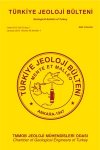
-
2025
-
2024
-
2023
-
2022
-
2021
-
2020
-
2019
-
2018
-
2017
-
2016
-
2015
-
2014
-
2013
- 2012
-
2011
-
2010
-
2009
-
2008
-
2007
-
2006
-
2005
-
2004
-
2003
-
2002
-
2001
-
2000
-
1999
-
1998
-
1997
-
1996
-
1995
-
1994
-
1993
-
1992
-
1991
-
1990
-
1989
-
1988
-
1987
-
1986
-
1985
-
1984
-
1983
-
1982
-
1981
-
1980
-
1979
-
1978
-
1977
-
1976
-
1975
-
1974
-
1973
-
1972
-
1971
-
1970
-
1969
-
1968
-
1966
-
1964
-
1963
-
1961
-
1959
-
1958
-
1955
-
1954
-
1953
-
1952
-
1951
-
1950
-
1949
-
1948
-
1947
View as PDF
Abstract: Kütahya Basin which is located near the northeast boundary of the Western Anatolia Extension Regionis a depression area that extends in WNW-ESE direction. Southern margin of the basin is bounded by adistinct fault morphology called Kütahya Fault Zone. Geological, geomorphological and geophysicalstudies on the Kütahya Fault Zone show that this zone consists of 5 different fault branches. Total length ofthe mapped fault zone is about 22 km in N50-70W direction. Paleoseismological and archeoseismologicalstudies show that there are at least two surface rupturing earthquakes during the last 8000 years. First earthquake was occurred around 6000 BC and the last one was around 1800 B.C. after which the SeyitömerTell was abandoned. Thus, this study indicates that the Kütahya Fault Zone has produced destructiveearthquakes during Holocene and considering the length of the fault zone, it is possible to suggest that thefault zone has earthquake potential at least 6.5 magnitude.
Abstract: Yozgat Volcanics is located in Central Anatolian Crystalline Complex within central Anatolia, and inthe northwest of the province of Yozgat. Middle-Upper Eocene Yozgat Volcanics are composed ofbasaltic andesite, andesite and dacite. Yozgat Volcanics show calc-alkaline character which presenceof plagioclase phenocryst with sieve texture and epitacsitic quartz xenocrystals prove magma mixing.Besides, geochemical analyses show that there are olivine-clinopyroxene fractionation from basalticandesite to andesite, and plagioclase-hornblende fractionation from andesite to dacite. In addition to that it has been observed that there is a signature of partial melting and continental contamination duringmagma evolution based on geochemical analysis.The northern branch of Neo-Tethys subducted beneath of Eurasia plate in central Anatolia in stageof Santonian-Campanian. Following this subduction event İzmir-Ankara Suture Zone occurred due tocontinent-continent collision. Lower-Middle Eocene basaltic rocks originated from mantle dasitic rocksoriginated partial melting of lower continental crust respectively. It has been thought that andesite wasformed by homogeneous mixing of basic and acidic volcanic rocks.
Abstract: The first official seismic zoning map of Turkey is prepared in 1945. According to the map, Turkey wasdivided in 3 regions as: Regions of High Damage, Dangerous Earthquake Regions and Regions withoutDanger. Seismic Zoning Maps of Turkey have been changed many times depending on the scientific andtechnological developments. The aim of this study is to give information about this maps (1945, 1947,1963, 1972 and 1996), which come in force at different dates since the introduction of the first officialEarthquake Zoning Map published in 1945 and is to assist for better understanding of the developmentphases of these maps.

 TMMOB
TMMOB